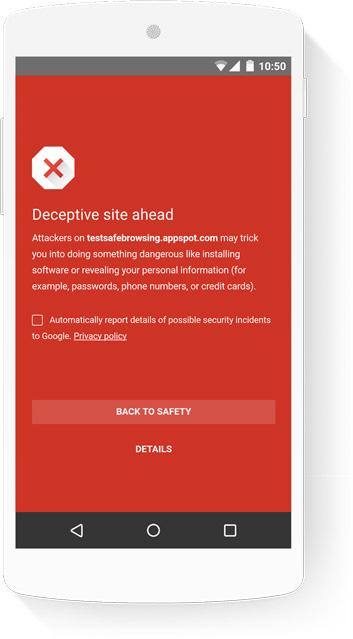
Making the world’s information safely accessible.
Safety First
Keeping over five billion devices safer.
Google Safe Browsing helps protect over five billion devices every day by showing warnings to users when they attempt to navigate to dangerous sites or download dangerous files. Safe Browsing also notifies webmasters when their websites are compromised by malicious actors and helps them diagnose and resolve the problem so that their visitors stay safer. Safe Browsing protections work across Google products and power safer browsing experiences across the Internet.
Our Transparency Report includes details on the threats that Safe Browsing identifies. The Transparency Report includes our Site Status diagnostic tool that you can use to see whether a site currently contains content that Safe Browsing has determined to be dangerous.

Product Protection
Safe Browsing protects Google and other products.

Chrome and Other Browsers
Chrome and other browsers use Safe Browsing to show users a warning message before they visit a dangerous site or download a harmful app. Our scanning infrastructure also protects the Chrome Web Store from potentially harmful extensions. Learn more

Search
Users see a Safe Browsing message in Search results when Safe Browsing has found that the site they’re about to visit might be dangerous. Learn more

Gmail
Safe Browsing protects Gmail users by identifying dangerous links in email messages and showing warnings if users click on them. Learn more

Android
Google and Android security teams collaborated to develop an app scanning infrastructure that protects Google Play and powers Verify Apps to protect users who install apps from outside Google Play. Safe Browsing also protects Chrome users on Android by showing them warnings before they visit dangerous sites. Learn more

Ads
Google’s Ads Security team uses Safe Browsing to make sure that Google ads do not promote dangerous pages. Learn more
Beginnings
A history of safety
Safe Browsing launched in 2005 to protect users across the web from phishing attacks, and has evolved to give users tools to help protect themselves from web-based threats like malware, unwanted software, and social engineering across desktop and mobile platforms.
Our Safe Browsing engineering, product, and operations teams work at the forefront of security research and technology to build systems that help users protect themselves from harm. Check out our Research and the Google Security Blog for updates on Safe Browsing and other Google security technology.

Increased Protection
Enhanced Safe Browsing
Users who require or want a more advanced level of security while browsing the web can enable Enhanced Safe Browsing.
Users who set up Enhanced Safe Browsing for their Google Account or Chrome browser will get the highest level of protection. We are always working to add new protections; some of the protections that are available now are listed below.
On Google Chrome, Enhanced Safe Browsing users will benefit from the following additional protections:
- Real-time checks against lists of known phishing and malware sites
- The option to request Google to perform deeper scans of files they’ve downloaded to check for malware and viruses
- Protection against previously unknown attacks when navigating to sites
- Tailored protections based on your risk level
Across other Google products, Enhanced Safe Browsing users will benefit from additional protections:
- Strengthened protections in GMail including additional checks on attachments and web links
- Tailored protection if an attack is detected on the account
By choosing Enhanced Safe Browsing, users will share additional security-related information in order to improve their online protection. This data is used only for security purposes and deleted after a short period of time. By sharing additional information about potential risky events, Chrome enables Safe Browsing to improve its ability to detect malicious content online, to better protect users all over the web.
Learn how to set up Enhanced Safe Browsing for your Google account.
Learn how to set up Enhanced Safe Browsing for Chrome.
API Documentation
Protection for all
To make the Internet safer for everyone, we’ve made Safe Browsing services free and publicly available for developers and other companies to use in their applications and browsers. Today, half the world’s online population is protected by Safe Browsing. If you are a developer and would like to protect your users from online threats, get started by visiting our API Documentation. If you are a webmaster, you can sign up for Google Search Console to receive notifications and help with security issues.
API Documentation
Policies
Safe Browsing gives users the ability to protect themselves from multiple types of unsafe sites and applications. Our policies help define the types of web threats about which Safe Browsing will notify users and webmasters.

Malware
Since 2006, Safe Browsing has warned users when they attempt to navigate to sites that might be malicious. Malware is software specifically designed to harm a device, the software it's running, or its users.
Learn more
Unwanted Software
In 2014, we added protection against a broad category of harmful technology that we now call “Unwanted Software”: for example, programs disguised as helpful downloads that actually make unexpected changes to your computer like switching your homepage or other browser settings to ones you don’t want.
Learn more
Social Engineering
Since 2005, Safe Browsing has protected users across the web from Social Engineering attacks. A Social Engineering attack tricks users into performing an action that they normally would not if they knew the true identity of the attacker. A common example is Phishing, where a page tries to steal a user's password or other personal data.
Learn more